
Daniel Skaar
About the Author
Daniel Skaar is a professional auction worker specializing in coin auctions. He has extensive experience organizing and managing auctions for a lot of numismatic items. In addition to his professional work, Daniel collects Buffalo nickels and studies their varieties and market trends.
He also maintains a blog where he shares practical information for collectors and auction participants.
Professional experience:
- Organizes and manages coin auctions in Norway and internationally
- Works with collectors, dealers, and institutions
- Provides consulting on coin Buffalo Head nickel value and market trends
Blog topics:
- How coin auctions work
- Guides on rare dateless Buffalo nickel value no date
- Updates on rare coin market trends
Connect with Daniel



What Is the Value of a Buffalo Nickel?
Buffalo nickels, also known as Indian Head nickels, are among the most popular and widely collected coins in American numismatics. They were minted from 1913 to 1938.
While many of them remain common and affordable, certain dates, mint errors, and high-grade examples can be worth hundreds or even thousands of dollars. Identifying valuable coins requires careful attention to details, e.g., mint marks, strike quality, and condition.
Key Factors Affecting the Value Buffalo Nickel
Both collectors and dealers use these criteria when evaluating a coin’s worth:
Date & Mint Mark
Certain date and mint mark combinations are significantly scarcer than others, and these key issues command higher prices at all grade levels.
- 1913-S Type 2
The first year of issue for the Type 2 reverse, with a reduced mintage of only 1.2 million pieces from the San Francisco Mint.
This coin is one of the top rarities in the series, highly sought after in all grades.
- 1926-S
The lowest mintage business-strike Buffalo nickel, with fewer than 1 million coins produced.
The 1926-S is rare in all grades, and well-struck, high-grade examples are extremely valuable.
- 1937-D 3-Legged Buffalo
A famous mint error caused by overpolishing of the reverse die, which resulted in the buffalo missing one front leg.
This variety is widely collected and regularly sells for several thousand dollars in higher grades.
Condition
The coin’s state of preservation strongly influences its market value:
- Worn coins with heavy circulation marks are typically valued at the low end of the market. The most heavily worn coins, especially with weak or missing dates, may sell for only a small premium over face value (just like the no date Buffalo nickel value).
- Uncirculated coins (graded MS-60 or higher) bring much higher prices, particularly for scarcer dates. Coins in MS-65 and above are especially prized by collectors due to their rarity and visual appeal.
- The overall eye appeal, surface quality, and absence of major contact marks are additional factors that contribute to higher values in the market.
“Full Horn” Detail
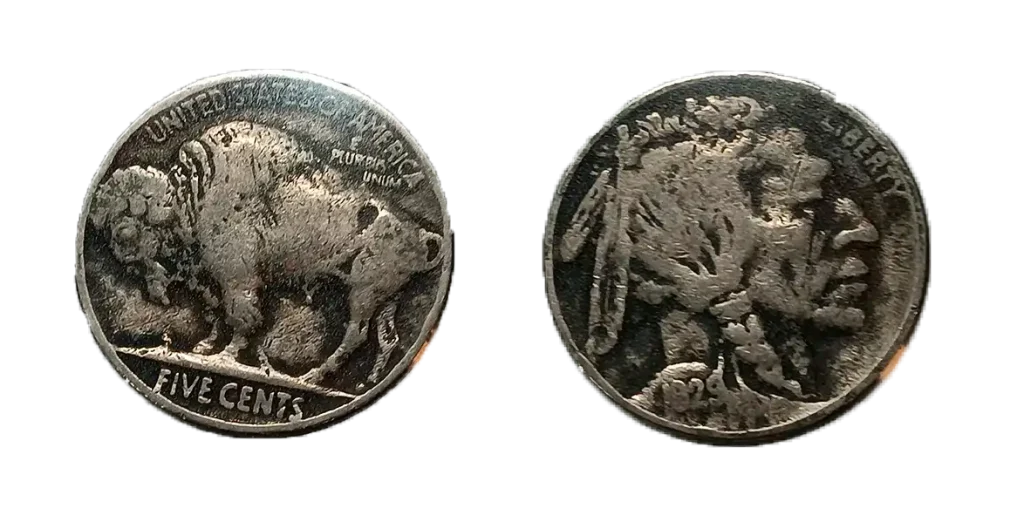
The visibility of the buffalo’s horn on the reverse of the coin is important for grading point used by collectors and professional grading services:
- Full Horn detail—where the entire horn is visible and well-defined—is an indicator of minimal wear and greatly increases value, especially on circulated coins.
- Partial or missing horn indicates moderate to heavy wear. Coins with weak horn detail are graded lower and bring correspondingly lower prices.
Full Horn is one of the first features collectors examine when determining if a circulated Buffalo nickel deserves a higher grade (VF or better).
Strike Quality
Minting quality varies significantly by mint location and year of issue.
Coins from the Denver (D) and San Francisco (S) mints are often found with weak strikes, particularly on the buffalo’s head, horn, and leg areas.
Well-struck examples from these mints are much more desirable and command premiums. Collectors pay close attention to sharpness of strike when evaluating coins from these branches.
Even common-date coins can bring higher prices if they exhibit a strong strike and full detail—especially important for assembling top-quality registry sets.
Grading Reference Guide
| Grade | Description | Visual Cues |
| VG (Very Good) | Heavily worn but identifiable | – Date is visible but weak- Horn is mostly worn flat or missing- Buffalo’s body outline clear but flat- Major legends readable |
| F (Fine) | Moderate wear, key features clear | – Full date visible but worn- Partial horn visible (typically base of horn only)- Buffalo’s tail and legs show wear but are complete- Lettering clear and bold |
| VF (Very Fine) | Moderate to light wear | – Full date, sharp and readable- ~50–75% of horn visible- Buffalo’s body shows some detail, hair may be visible- Reverse details sharper but some flat areas remain |
| EF (Extremely Fine) | Light wear on high points | – Full, sharp date- ~75–90% of horn visible- Buffalo’s shoulder, hip, and tail show good detail- Much of the original surface detail remains- Fields may show minor wear |
| AU (About Uncirculated) | Very minimal wear | – Full, bold date- Full horn clearly visible- Only trace wear on buffalo’s high points (shoulder, hip, horn)- Mint luster present on most of the surface- No major marks or discoloration |
| MS (Mint State) | No wear from circulation | – Full, sharp date and horn- Buffalo fully detailed, no signs of wear- Full original mint luster throughout- Strike sharpness and eye appeal vary by grade (MS-60 to MS-70)- Contact marks and surface quality determine specific MS grade |
Buffalo Nickel Value Chart (Circulated & Uncirculated – 2024)
| Year – Mint | F‑12 | VF‑20 | EF‑40 | AU‑50 | MS‑63 | MS‑64 | MS‑65 | MS‑66+ |
| 1913 D (Type 2) | $144 | $157 | $180 | $208 | $320 | $425 | $530 | $1,188+ |
| 1913 S (Type 2) | $350 | $400 | $379 | $484 | $605 | $947 | $1,375 | $1,770+ |
| 1914 D | – | $99 | $150 | $200 | $444 | $550 | $753 | $1,423+ |
| 1915 S | – | $75 | $100 | $195 | $553 | $821 | $1,563 | $2,310+ |
| 1916 doubled die | – | – | – | – | $67,500 | $155,250 | $272,500 | – |
| 1918/7‑D Overdate | – | $516 | $1,313 | – | – | – | – | – |
| 1926 S | – | – | – | – | – | – | – | “semi‑key” ~$30 in VF |
| 1937 D (3‑Leg) | – | – | – | – | – | – | – | ~$550 in collector grades |
Buffalo Nickel No Date Value
Those without a visible date are common and generally have low collector value. Because the date was struck on a high point of the coin, it wore off quickly in circulation.
- Common no-date: $0.50 to $1 (bulk value for cull or filler coins)
- Full Horn + no date: $1 to $3, depending on eye appeal
- Errors or off-metal strikes: Value can be higher, but must be professionally authenticated
- Restored-date nickels (date chemically revealed): $0.50 or less — viewed negatively by most collectors
Most Valuable Buffalo Nickels
Key Date Rarities
1. 1913-S Type 2 — $1,000–$10,000+
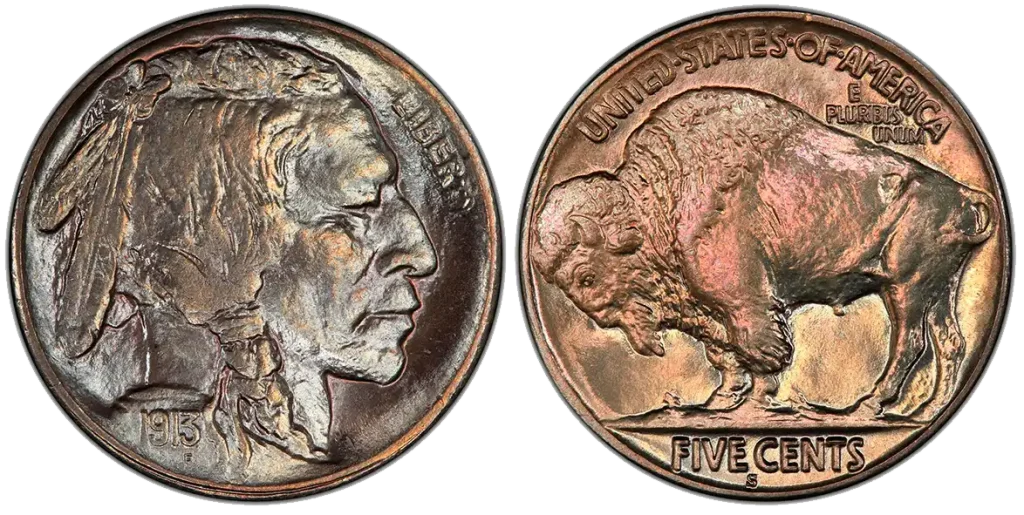
- Mintage: 1,209,000
The 1913 issue was produced in two types: Type 1 (raised mound) and Type 2 (flattened ground).
The San Francisco Type 2 nickel is one of the lowest mintage regular issues of the series. Even in lower grades, prices start around $1,000.
High-grade specimens (MS-65 and higher) regularly achieve $10,000+ at auction due to rarity and demand.
2. 1926-S — $500–$20,000+
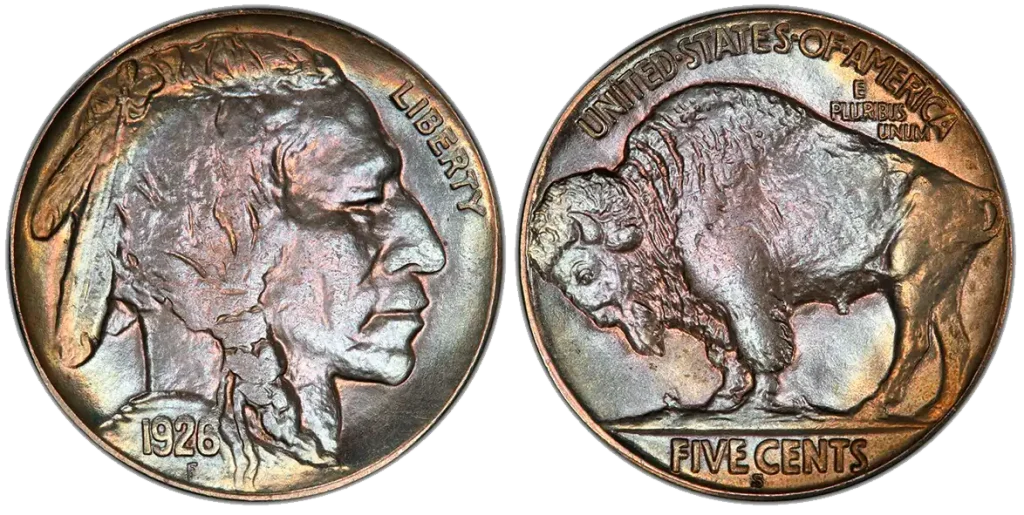
- Mintage: 970,000 (lowest business strike mintage of the entire series)
Most 1926-S nickels were weakly struck and heavily circulated, making sharply struck, high-grade examples extremely scarce.
Values start at around $500 in VF condition and climb steeply in AU and MS grades.
A fully struck MS-65 1926-S nickel can sell for over $20,000, and MS-66 coins are nearly impossible to find.
3. 1937-D 3-Legged Buffalo — $1,500–$50,000+
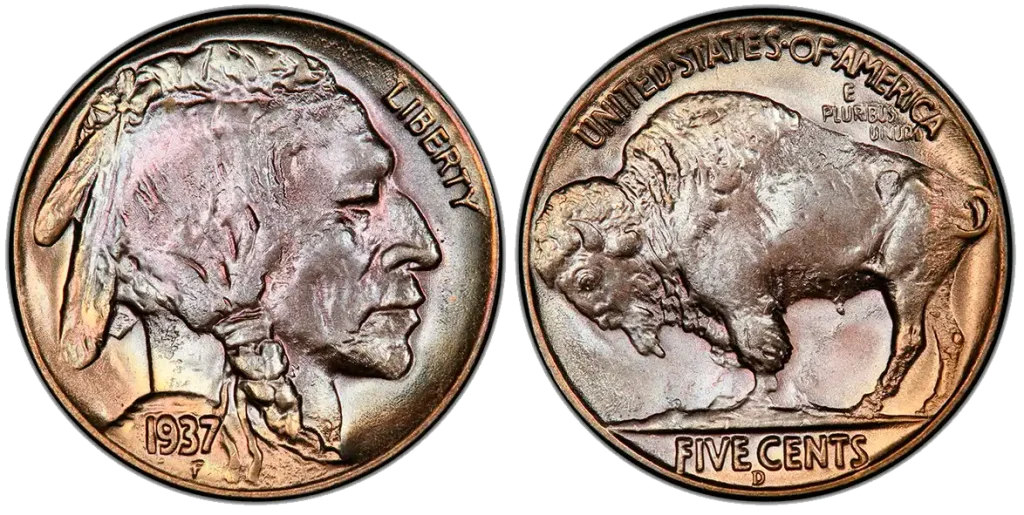
This famous error resulted from a Denver Mint die being overpolished, which removed part of the front right leg of the buffalo.
The variety was discovered early, but many circulated before the error was widely known.
The 3 Legged Buffalo nickel value prices begin around $1,500 for well-worn examples.High-grade coins (MS-64 to MS-66) often sell for $25,000 to $50,000+ at auction.
Condition Rarities
Full Date (No Wear)
Buffalo nickels were struck with dates that often wore away quickly due to their placement on a high part of the design.
Many circulated examples lack a full, legible date.
Coins with a complete, sharp date are worth 50–200% more than similar coins with worn or partial dates.
This premium applies across all dates but is especially important for key date coins and early issues (1913–1916).

Full Horn Detail
Graders and collectors look closely at the buffalo’s horn on the reverse as a quick indicator of wear.
A Full Horn (entire top portion of the horn visible and distinct) is often required for a coin to be certified as Very Fine or better.
Lack of horn detail significantly reduces a coin’s value, even if the rest of the design is relatively strong.
Coins with sharp horn detail command notable premiums, especially on notoriously weak-strike issues like 1926-S and other branch mint coins.
Mint State (MS-65 and higher)
Few nickels were saved in uncirculated condition, and even fewer survived with gem (MS-65 or higher) surfaces.
Mint State examples, particularly of key dates and weak strike issues, can be worth 10 to 100 times more than similar dates in circulated grades.
Factors that contribute to top-grade value:
- Strike sharpness
- Luster
- Absence of contact marks
- Eye appeal
For instance, an MS-65 1926-S nickel is valued over $20,000, while a well-circulated VF coin might fetch only $500.Even common dates (like 1938-D) can sell for $1,000+ when graded MS-67 or MS-68 with full detail.
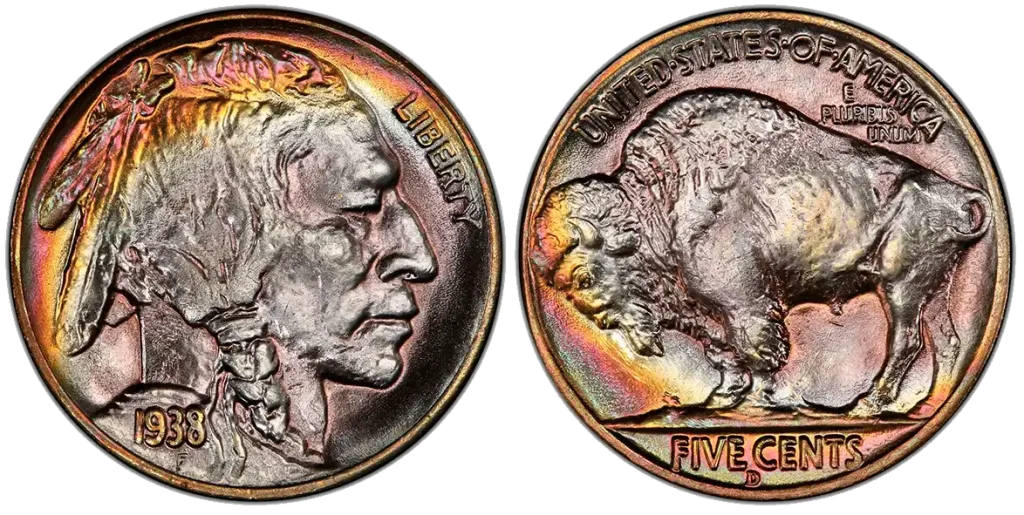
How to Identify a Valuable Buffalo Nickel
1. Check the Date & Mint Mark
The date appears on the obverse (front) of the coin, above the buffalo’s head.
The mint mark appears on the reverse (back), directly beneath the words “FIVE CENTS.”
D = Denver Mint
S = San Francisco Mint
No mint mark = Philadelphia Mint
Certain date and mint mark combinations are much rarer and more valuable.
2. Examine the Horn & Date
- Full Horn: A sharp, complete buffalo horn indicates limited wear and higher value. Collectors prefer coins with clear horn detail for grading purposes.
- Weak Date: The date on Buffalo nickels is located on a high point of the design and is often partially worn or missing. A strong, complete date significantly increases a coin’s value. A weak or missing date greatly reduces value, even on otherwise scarce issues.
3. Look for Errors
Certain error varieties are highly collectible and can command substantial premiums:
- 1937-D 3-Legged Buffalo: The buffalo’s front right leg is missing due to an overpolished die. This is one of the most famous errors with a high Three Legged Buffalo nickel value.
- 1916 Doubled Die Obverse (1916/1916): The date and parts of the obverse show strong doubling. This variety is rare and highly desirable in all grades.
- Off-Metal Strikes: Occasionally, coins were mistakenly struck on the wrong planchet (such as a cent planchet). These off-metal errors are rare and can be worth hundreds or thousands of dollars.
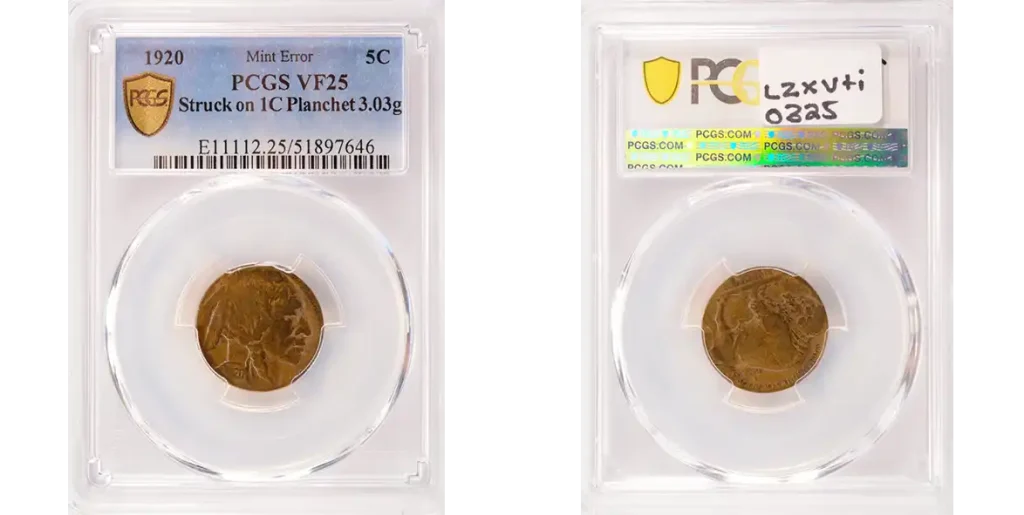
FAQs
How can I tell if my Buffalo nickel is silver?
No were ever struck in silver, i.e. no silver Buffalo nickel value. All were made from a composition of 75% copper and 25% nickel. If your coin appears silver-colored, it may be:
- A cleaned or polished coin
- A coin with natural toning
- An off-metal error (rare—requires professional verification)
If uncertain, weigh the coin or have it tested by a numismatic expert.
Should I clean my old Buffalo nickel?
No. Cleaning coins—especially older or collectible ones—lowers their value.
Even light cleaning can leave marks that are obvious to professional graders and experienced collectors. It is best to leave the coin in its original state and store it properly in a protective holder.
Why do some Buffalo nickels have no date?
Buffalo nickels often have missing or partial dates because the date was struck on a high point of the design.
With circulation wear, this part of the coin eroded quickly.
The value of Buffalo nickel with no date is less than fully dated coins.
Some collectors attempt to restore dates using chemical methods, but this also lowers collectible value.
How much is a 1936 Buffalo nickel worth?
It is common compared to key dates but still collectible:
- In circulated condition, typical value ranges from $1 to $5.
- High-grade uncirculated examples (MS-63 or higher) can bring $20 to $100, depending on strike quality.
- 1936-D and 1936-S mintmark versions in high grade are worth more.
- Any 1936 Buffalo nickel with Full Horn and sharp detail commands a stronger premium.
Key Takeaways
1. Most Buffalo nickels are worth $1–$50
The majority were heavily circulated.
Common dates and worn examples typically sell for $1 to $5 in low grades.
Better-preserved common dates can bring $10 to $50 in higher circulated or lower uncirculated grades.
2. Key dates are highly valuable
Certain dates and varieties are scarce and command much higher premiums:
- 1913-S Type 2: $1,000–$10,000+
- 1926-S: $500–$20,000+
- 1937-D 3-Legged Buffalo: $1,500–$50,000+
Collectors should always check for these key dates and verify authenticity before buying or selling.
3. Full horn and sharp date increase value
Two simple visual factors greatly affect a coin’s worth:
- Full Horn: A complete buffalo horn with sharp detail shows the coin has minimal wear. It is often required for grading VF and higher.
- Sharp Date: Many lost their dates to wear. A fully readable date always adds value and is essential for identifying rare dates and varieties.
Coins with both full horn and sharp date bring 50–300% higher prices than similar coins without these features.
4. Never clean your coins
Cleaning is one of the most damaging things you can do to a collectible coin:
- Even light cleaning leaves visible scratches or dulls original luster.
- Cleaned coins are often rejected by professional grading services or marked as “Cleaned”, severely lowering their market value.
- Always leave coins in their original state and store them properly to preserve the rare Buffalo nickel value no date (or with it).